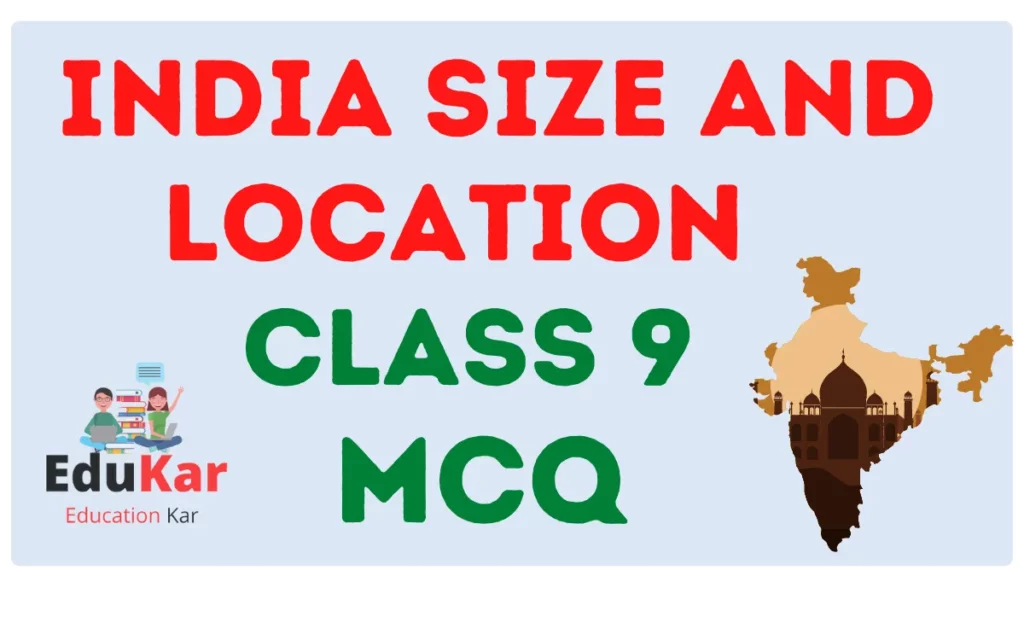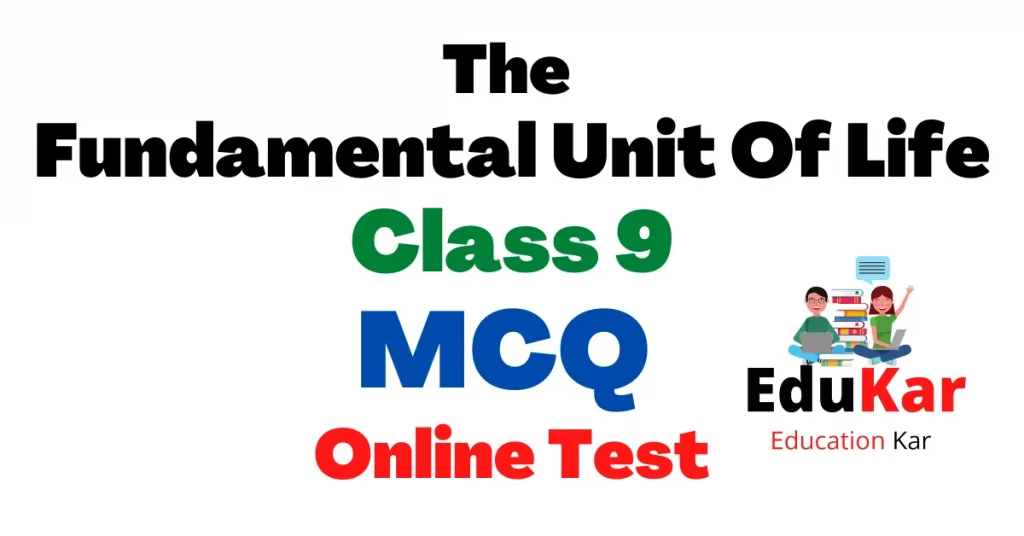| Chapter | Motion |
| Type | MCQ (Mutiple Choice Questions |
| Class | 9th |
| Subject | Science |
| Board | CBSE |
What is Motion?
Motion refers to the movement or change in position of an object over time. It can be described in terms of distance, velocity, and acceleration. The study of motion is known as mechanics. There are different types of motion, including linear motion (motion in a straight line) and rotational motion (motion around an axis). The laws of motion, first described by Sir Isaac Newton, form the basis of classical mechanics and explain the behavior of objects in motion.

MCQ for Class 9 Science Chapter 8 Motion with Answers
1. What would be the displacement of a molecule moving in a circular path of radius r after a displacement of half a circle?
(a) 2πr
(b) πr
(c) 2r
(d) Zero
Answer: (c) 2r
2. The path length moved by a body in a given time interval is known as _____.
(a) distance
(b) velocity
(c) acceleration
(d) moment
Answer: (a) distance
3. Which of the below situations is true & possible?
(a) The acceleration of a body can be non-zero even though its velocity is zero.
(b) Despite its continual motion, a body might experience acceleration.
(c) In a circular motion, the magnitudes of distance and displacement are identical.
(d) All of the above
Answer
Answer: (a) The acceleration of a body can be non-zero even though its velocity is zero.
4. The definition of velocity is ____ per time.
(a) distance
(b) displacement
(c) power
(d) acceleration
Answer: (b) displacement
5. A body moving in a straight line has a constant motion if it travels _____ distance in equal time intervals.
(a) equal
(b) Unequal
(c) Short
(d) long
Answer: (a) equal
6. Suppose a boy is moving with a constant velocity of 10 m/s on a merry-go-round ride. Which of the below is true of the given scenario?
(a) The boy is at rest
(b) The boy is moving with zero acceleration
(c) The boy is moving with accelerated gesture
(d) The boy is moving with constant velocity
Answer: (c) The boy is moving with accelerated gesture
7. What is indicated by the slope of the time-distance graph?
(a) speed
(b) velocity
(c) acceleration
(d) displacement
Answer: (a) speed
8. What info does the velocity-time graph’s slope provide?
(a) speed
(b) velocity
(c) acceleration
(d) displacement
Answer: (c) acceleration
9. Which of the below is true of a free-falling body?
(a) It moves with non-uniform gesture
(b) It has 0 velocity
(c) It has uniform non-zero acceleration
(d) It has non-constant acceleration
Answer: (c) It has uniform non-zero acceleration.
10. The physical quantity that has both direction & magnitude is called as
(a) vectors
(b) scalars
(c) Both(a) and (b)
(d) Neither (a) or (b)
Answer: (a) vectors
11. The acceleration’s direction matches the direction of _______.
(a) displacement
(b) change in velocity
(c) velocity
(d) all of these
Answer: (b) change in velocity
12. The area below a velocity-time graph gives __________.
(a) distance
(b) acceleration
(c) speed
(d) displacement
Answer: (d) displacement
13. ________can be add up algebraically.
(a) Accelerations
(b) Velocities
(c) Distances
(d) Any physical quantities
Answer: (c) Distances
14. A physical quantity which has both direction & magnitude is known as _______.
(a) scalar quantity
(b) vector quantity
(c) neither (a) nor (b)
(d) either (a) or (b)
Answer: (b) vector quantity
15. The distance-time graph of a body in motion along a straight path in a single direction with uniform speed will be _____.
(a) along X-axis
(b) a line with positive slope
(c) parallel to X-axis
(d) None of these
Answer
Answer: (b) a line with positive slope
16. If an object travels unequal distances in equal periods of time along a _______ path, the body is known to be in ___________.
(a) curved, uniform motion
(b) pentagonal, uniform motion
(c) rectangular, uniform motion
(d) straight, non-uniform motion
Answer: (d) straight, non-uniform motion
17. A freely falling object is known to be moving with _____.
(a) uniform non-zero acceleration
(b) non-uniform motion
(c) zero velocity
(d) non-uniform acceleration
Answer: (a) uniform non-zero acceleration
18. An object travels along a straight path from its initial position to a point 20 m away & then returns back to its starting position. The change in the position of an object is ____ & the distance covered is ______.
(a) 20 m, 40 m
(b) 0 m, 40 m
(c) 40 m, 40 m
(d) 0 m, 0 m
Answer: (b) 0 m, 40 m
19. The slope of a velocity-time graph indicates__________.
(a) distance
(b) speed
(c) acceleration
(d) displacement
Answer: (c) acceleration
20. The position-time graph of an object is parabolic, then the object is ______.
(a) in non-uniform motion
(b) in uniform acceleration
(c) at rest with some initial distance covered
(d) at rest with 0 initial distance covered
Answer: (b) in uniform acceleration
21. An object covering equal distances in equal intervals of time is said to be moving with constant velocity if the body moves along a _________ path.
(a) straight
(b) rectangular
(c) circular
(d) hexagonal
Answer: (a) straight
22. The slope of a distance-time graph indicates_______.
(a) displacement
(b) acceleration
(c) velocity
(d) speed
Answer: (d) speed
23. If an object covers equal distances in equal intervals of time, then_______.
(a) the object is moving with constant velocity
(b) the object is moving with constant acceleration
(c) the object may be moving with constant velocity
(d) the object is moving with constant deceleration
Answer: (c) the object may be moving with constant velocity
24. The distance-time graph of the motion of an object is parallel to X-axis, then the object is ______.
(a) at rest with zero initial distance travelled
(b) at rest with some initial distance travelled
(c) in non-uniform gesture
(d) constant acceleration
Answer: (b) at rest with some initial distance travelled
25. Identify the sentence which is true
Sentence A: Average velocity of an object may be equal to the instantaneous velocity of the object.
Sentence B: The speed-time graph of an object which is in constant motion will be a straight-line coinciding with X-axis.
(a) Statement A is true
(b) Statement B is true.
(c) Both statements A, B are true.
(d) Neither statement A nor statement B is true.
Answer: (a) Statement A is true
26. Which is the most simple kind of motion among the options below?
a) Motion in straight line
b) Motion in plane.
c) Motion in space
d) Motion of projectile.
Answer: (a) Motion in straight line
27. If a body moves 4 km in a straight line then the value of displacement is….
a) 4 km
b) 8 km
c) 12 km
d) 0 km
Answer: (d) 0 km
28. Speed based on…
a) Path length
b) Displacement
c) Initial & final position of the body.
d) None of these.
Answer: (a) Path length
29. Velocity of the particle lies on….
a) Distance
b) Displacement
c) Path of the object
d) None of these.
Answer: (b) Displacement
30. The area of the speed time graph is marked by…
a) Distance
b) Acceleration
c) Velocity
d) Speed
Answer: (d) Speed
31. We can derive the 1st equation of kinematics from the formula of….
a) Distance
b) Speed
c) Acceleration
d) Velocity
Answer: (c) Acceleration
32. Which of the below is the example of constant motion.
a) Zig-zag motion of butterfly
b) Motion of aero plane before take off
c) Motion of periods of soldiers.
d) Motion of fan after switch off.
Answer: (c) motion of soldiers
33. A bus is travelling at a speed of 10 m/s. How much time is needed to stop that bus if the driver slows it down at the rate of 2 m/s².
a) 5 seconds
b) 10 seconds
c) 4 seconds
d) 8 seconds
Answer: (a) 5 seconds
34. If you throw any kind of ball in an upward direction then the value of g will be…
a) Positive
b) Negative
c) We can not say
d) It is not fixed
Answer: (a) positive
35. Suppose a child is enjoying a ride on a marry-go-round which is moving with a uniform speed of 10 m/s. It implies that the child is:
(a) At rest
(b) Moving with no acceleration
(c) In accelerated motion
(d) Moving with uniform velocity
Answer: (c) In accelerated motion




![[MCQ] Probability Class 9 Important Questions Probability Class 9 MCQ](https://edukar.org/wp-content/uploads/2022/09/Probability-Class-9-MCQ-1024x536.webp)